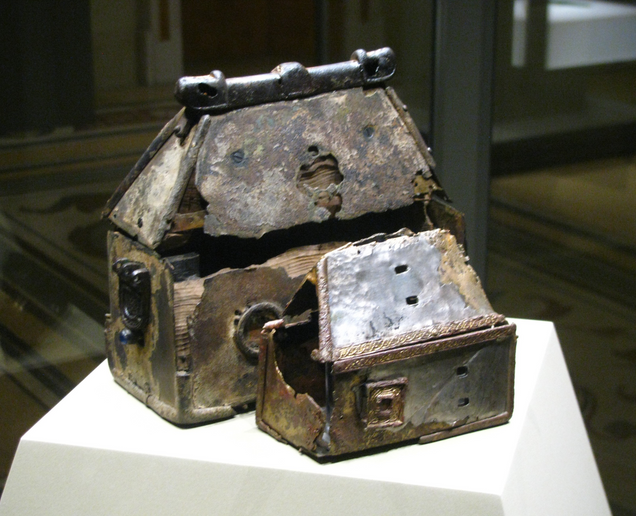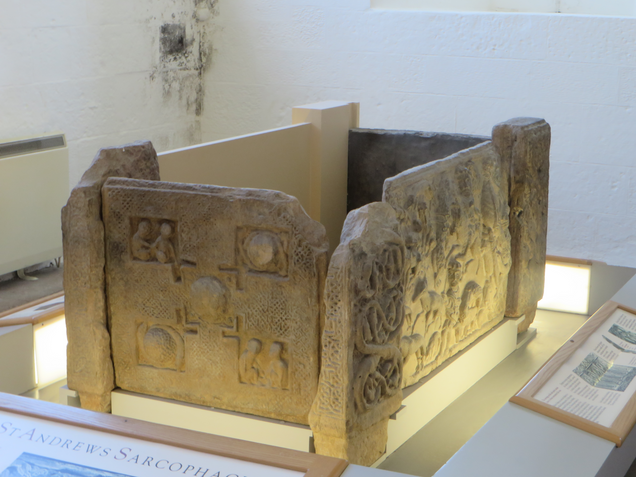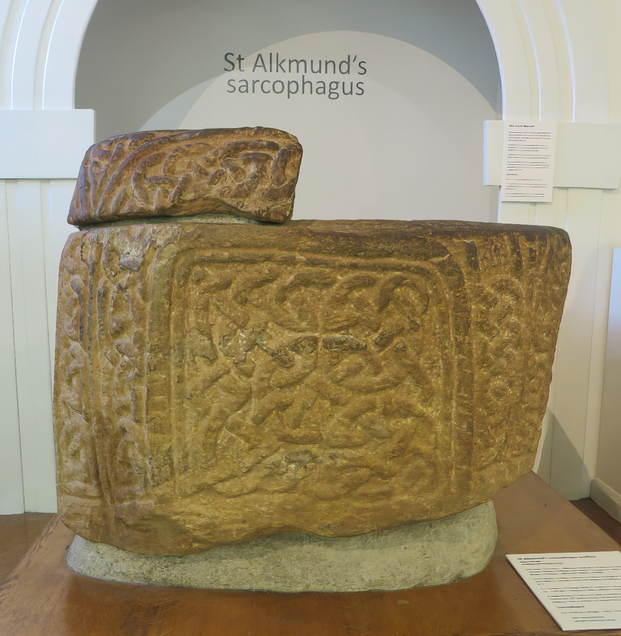Skeuomorphic Textiles: Stitches in Stone
by Tracey Davison

This essay considers the ninth-century sarcophagus of St. Alkmund as a skeuomorphic funerary textile and its role in the commemoration and creation of a visible presence of the deceased (fig. 1).1 Now in the Derby Museum and Art Gallery in England, it was unearthed between 1967-68 during the demolition of the nineteenth-century St. Alkmund’s church. The sarcophagus’ ninth-century date makes Ealhmund (son of the deposed King Alcred of Northumbria) its most likely occupant; he was killed on the orders of Eardwulf of Northumbria during his exile in Mercia.2 The sarcophagus was reputedly commissioned by the Mercian king Coenwulf (c. 740-821), who may have taken the opportunity to display a martyred prince while simultaneously making a political and religious comment on the actions of Eardwulf and Northumbrian royalty.3
In considering the carved decoration of the sarcophagus, this essay suggests that we are faced with a skeuomorphic textile that emphasizes the features of woven cloth; its rich interlace pattern, demonstrated through the defining of individual strands, reveals the complexities of the weave to the viewer that are present but not visible in textile. It could be construed as a celebration of the embroiderer’s art (in its original form) and its role in denoting hierarchy through elaborate textiles used in a liturgical context.
With this in mind, it is worth exploring whether the woven structure of cloth should be considered a framework for design and how such material might be translated into stone. Skeuomorphic textiles demonstrate the unrestricted, fluid nature of Anglo-Saxon art which often integrates multiple forms of media into artistic practices. The resulting symbolism is often directly related to that of the original model. For a lay viewer, visibility and accessibility of an embroidered vestment would always be removed through the physical distance lying between clergy and congregation. The latter would be aware of the effect created by candlelight on the gold thread but would be unable to fully visualize the intricate stitches. In the case of the St. Alkmund Sarcophagus, the haptic features of the textile model, embroidered in relief upon the ground fabric, are exaggerated in the skeuomorph; the interlace carving merges the moveable aspect of the weave with the solidity of the stone, creating the ambiguity of a solid material that gives the appearance of movement and flexibility. By referencing relatively flat textiles, the teasing apart of the strands creates negative space between and behind the carving, resulting in a stone block appearing to be both solid and hollow.
The depth of the surface carving and interplay between light and shadow on the St. Alkmund Sarcophagus makes it difficult to establish where the surface design ends and the core of the monument begins. Therefore, the viewer is faced with what art historian Jane Hawkes has described as “symbolic ambiguity.”4 The precious textile recreated in the resilient stone has taken on the characteristics of the more fragile material. The stone’s solidity—its most defining feature—becomes ambiguous when rendered as a skeuomorphic textile. One of the primary purposes of cloth is to cover and protect the body; therefore, the presence of a skeuomorphic textile must be part of a visual language designed to inform the viewer about the status of the deceased as well as the nature of the original object.
This materiality has implications for the spiritual value of labor, both for the original weavers and embroiderers, and the sculptor of the skeuomorph. The use of cloth for shrouding the deceased demonstrates the important role of elaborate textiles in denoting both piety and sanctity. Almost invariably, relics are kept in protective reliquaries; the additional act of wrapping them in an elaborate textile refers to the corporeal nature of many relics (fig. 2).5 A relic may be merely a fragmentary piece of bone but it is still venerated as the living body of the saint, through the suspension of the anonymity of bodily remains and the normal laws of the grave.6 By giving the skeuomorph the appearance of being wrapped in textile, combined with the animated relief decoration representing the embroidery, the stone becomes an object of veneration and would be recognized as such. Skeuomorphic textiles can be viewed as objects of performative piety: the enhanced elements of elaborate textiles and their religious connotations are created to occupy a space and elicit a visual and emotional response.7 The interactions of the viewers or users of the skeuomorph build on this framework of familiarity, the “suggestiveness of ornament,” projecting its message forward while simultaneously acknowledging the meaning of the original textile model.8

Anglo-Saxons felt compelled to create visual symbols of power that would survive, and stone could replace the vulnerability of textile. Strength, mass, presence, and longevity are all qualities inherent to stone, but—in the case of skeuomorphic textiles—an emphasis is placed on embroidery because of its role in Church hierarchy. The gifting of elaborate textiles—especially of Eastern origin, such as silk from Constantinople adorned with religious motifs—denoted the reaches of the Christian world and reinforced the Church as a presence in both East and West.9 As noted in the later entries of the Liber Pontificalis (eighth to ninth centuries), the numerous papal donations of elite textiles to the churches of Rome raised both the profile of donor and recipient, and this status enhancement would equally apply to the patron who commissioned
St. Alkmund’s sarcophagus. A corollary to this lies in the potential of elaborate textiles as moveable furnishings, as they can journey through provenance, production, procurement, purpose and time; however, a skeuomorphic textile rendered in stone demonstrates a permanence and continuity of display.
St. Alkmund’s sarcophagus is a skeuomorphic textile which exhibits interlace as its dominant pattern, with decoration covering both the remaining section of lid and the body of the object (fig. 3). If Coenwulf’s intentions were to create a saint and a shrine, then the maintenance of an unsullied body and the condition of the clothing within the grave were of the utmost importance. This is demonstrated in Bede’s account of Cuthbert (Bishop of Lindisfarne 685-687) whose coffin was opened eleven years after his death; his body was found to be incorrupt and his liturgical vestments intact, thus elevating him to the status of saint.10 Therefore, the creation of an essentially incorruptible textile in the form of a skeuomorphic sends a powerful message about both the deceased and the patron.

The sarcophagus was discovered broken into three sections in the south-east corner of the nave with its lid level with the twelfth-century floor of the church, meaning it had been deliberately placed to ensure its continued visibility, presumably because of its connection to St. Alkmund. As archeologist C. A. Radford has demonstrated, if the sarcophagus originally stood in the same place when above ground, it would have occupied an important position next to the altar. The reconstruction of the monument by the conservators at Derby Museum revealed a dressed stone underside, implying that it was intended to stand on the floor.11 Due to the decoration on all sides, perhaps circumambulation would have allowed for continued contemplation of the interlace pattern, thereby implying that the lack of figural ornament did not detract from the significance of the object, therefore rendering the skeuomorphic textile a contemplative tool. Furthermore, the small grains of quartz in the stone would have caught the candlelight across the undulating strands of carved interlace and highlighted the contrast between pattern and negative space.12 As the viewer moved around it, they would have been confronted by a stone coffin that combined light, shade, and carved relief that appeared to move with them. Given that a key purpose of a funerary monument is to keep the memory of the deceased alive, the monument’s capacity to physically respond to its surroundings would suggest the enduring presence of the deceased.
Compared to the figural carving on the St. Andrew’s sarcophagus, the decoration on St. Alkmund’s has been called “unambitious” by Radford (fig. 4).13 Such judgments fail to acknowledge the complexity of the non-figural, and that the production of carved interlace required skill to create the linear precision of positive and negative patterns, as well as hidden crosses. Sidebottom also implied that the decoration lacks precision, drawing attention to the variety of patterns used and the way they were combined by the sculptor(s); for Sidebottom, non-uniformity implied multiple makers.14 Yet, as a skeuomorphic textile, variation could equally point to complex patterning being embraced by the textile worker or stone carver. In this case, the scale and purpose of the piece suggests an experienced hand familiar with high-status decorative textiles.

Rather than interpreting the patterns and panels as at odds with each other, they can be thought of as the separate elements that create texture and ornament akin to an embroidered textile. It may also be useful, from a skeuomorphic perspective, to imagine the panels of the sarcophagus as areas of a flat funerary textile with the tapering corner details widening towards the middle of the cloth drawing the viewer’s eye to the central decoration, which is occupied by the lid (fig. 5).

It may also be possible to explain the jumbling of pattern towards the bottom of the narrow corner panels noted by Sidebottom, not as sloppy workmanship, but rather as a faithful replication of the drape of the original textile in stone.15 In his piece on the geometry of the Lindisfarne Gospels (London, BL, Cotton MS Nero D IV), Guilmain also touches on the subject of pattern irregularity. He proposes that manipulation of pattern structure does not disturb the design; rather, it mitigates the geometric rigidity.16 Perhaps one could see this as a deliberate choice designed to represent the softer, more irregular shapes of an elaborate textile rather than the precisely drawn lines of a carpet page in a manuscript.
There is a danger that the scale of an object such as St. Alkmund’s sarcophagus may lead to physical presence overshadowing the conceptual, symbolic nature of the skeuomorph. It is important to note that the design of the skeuomorph’s textile model was a mere idea prior to being rendered in silk and gold thread. With the goal of mimesis in mind, the maker of the skeuomorph may have responded to the physical properties of the textile. Equally, they were motivated by the same considerations as the original needlewomen and the hand that draped the cloth across the coffin. In the case of a skeuomorph, it is important to consider the creative process of the maker who represented a flexible and precious textile—which would have responded to the form beneath—in resistant stone. The purpose of a funeral pall was not to hide the coffin but to “dress” it, thus acknowledging its importance. The degree of thought and contemplation required to reconcile two such disparate materials is evidenced by responses to the skeuomorphic textiles and the conviction that what we are looking at is indeed, as Boulton points out, “embroidered stones.”17
____________________
Tracey Davison is a PhD candidate in Medieval Studies at the CMS, York. Her thesis addresses the absence of a body of scholarship devoted to the use and perception of textiles and clothing in Anglo-Saxon England, examining the degree to which the art historical and archaeological evidence for early medieval textiles, clothing and adornment can be woven into and supported by the literature (vernacular and Latin, secular and ecclesiastical) produced and circulating in Anglo-Saxon England.
____________________
Footnotes
1. Skeuomorphs are defined as “powerful devices retaining a rich symbolism and possibly evoking an emotional or at least, cognitive response through their relationship with their previous incarnation of the other object, and the associated memories and significance therein.” Meg Bolton, “Embroidered Stones; Considering the Symbolism of Anglo-Saxon Skeuomorphs and the Kirkdale Grave-Slab,” in The Art, Literature and Material Culture of the Medieval World: Transition, Transformation and Taxonomy, ed. Meg Bolton, Meg Hawkes, Jane Herman (Dublin: Four Courts Press, 2015), 203.
2. D. W. Rollason, “The Cults of Murdered Royal Saints in Anglo-Saxon England,” Anglo-Saxon England 11 (1982): 4.
3. Rollason, “The Cults of Murdered Royal Saints in Anglo-Saxon England,” 4. “Northumbrian ambition to control the British borderlands as far south as Shropshire developed into an ambition to dominate the entire island.” T. M. Charles-Edwards, Wales and the Britons, 350-1064 (Oxford: Oxford University Press, 2014), 388.
4. Jane Hawkes, “Symbolic Lives: The Visual Evidence,” in The Anglo-Saxons from the Migration Period to the Eighth Century: An Ethnographic Perspective, ed. John Hines (Woodbridge, Suffolk, UK: Boydell Press, 1997), 334.
5. Peter Brown, The Cult of Saints: Its Rise and Function in Latin Christianity (Chicago: University of Chicago, 1980), 11.
6. Brown, The Cult of Saints, 11.
7. Howard Williams, “Engendered Bodies and Objects of Memory in Final Phase Graves,” in Burial in Later Anglo-Saxon England c. 650-1100 AD, eds. Jo Buckberry and Annia Cherryson (Oxford: Oxbow Books, 2010), 28.
8. Emmanuelle Pirotte, “Hidden Order, Order Revealed: New Light on Carpet-Pages,” in Pattern and Purpose in Insular Art, ed. Rednap et al. (Oxford: Oxbow Books, 1998), 204.
9. “On these holy martyrs’ altar he furnished 2 cloths, one of which he wondrously adorned with a gold-studded, gold-interwoven cross, the other with fourfold-woven silk; he also adorned 7 great gold-interwoven veils, sewn around with a purple fringe”. Raymond Davis, The Lives of the Ninth-Century Popes (Liber Pontificalis): The Ancient Biographies of Ten Popes from A.D. 817-891(Liverpool: Liverpool University Press, 1995), 8. The Liber Pontificalis records the biographies, decrees and church building programmes including the furnishings and elaborate textile donations of the popes between the first and the ninth century.
10. Bede, Ecclesiastical History of the English People, trans. Bertram Colgrave and R. A. B. Mynors (Oxford: Oxford University Press, 2007), I. xxix, 105.
11. C. A. Ralegh Radford, “The Church of St Alkmund, Derby,” The Derbyshire Archaeological Journal 96 (1976), 35.
12. Hawkes and Sidebottom, Derbyshire and Staffordshire, 170.
13. Jonathan Jerrett, “St Alkmund’s Derby – A Corner of Tenth-Century Europe”, A Corner of Tenth-Century Europe, 2019.
14. Hawkes and Sidebottom, Derbyshire And Staffordshire, 171.
15. Hawkes and Sidebottom, 171.
16. Jacques Guilmain, “The Geometry of The Cross-Carpet Pages in The Lindisfarne Gospels,” Speculum 62, no. 1 (1987): 24.
17. Meg Boulton, Embroidered Stones, 198-216.